Taormina is the main tourist destination in Sicily and due to its beauty and particularity it is called the pearl of the Ionian. Already during the Grand Tour period, in the 19th century, it was a popular destination for writers, artists and intellectuals. In the past it was dominated by different civilizations that followed one another, such as Greeks, Romans, Arabs, Normans and French. The village lies among the hills, about 200 meters from the sea with Mount Etna guarding it.
Tip from Topsecretsicily: In Taormina you can book various tours and experiences, such as dolphin-viewing boat rides, tickets to Taormina’s ancient theater skipping the long line, day tours to Mount Etna’s craters, and more.
1. The Greek Theater of Taormina
The Greek theater of Taormina it is probably the main attraction of the Ionian pearl. The spectacle that you can admire will be truly exciting, Etna (often erupting) on one side, the sea on the other and the green hills overlooking the Mediterranean.
The theater was built in the Hellenistic period around the third century BC and at the time the capacity was about 5,000 spectators, only to reach 10,000 after the changes made to the theater by the Romans. With the advent of the latter, in fact, the theater was heavily modified and intended to stage fights between gladiators and wild beasts.
Topsecretsicily tip: Here you can buy tickets to the Greek theater and skip the line.
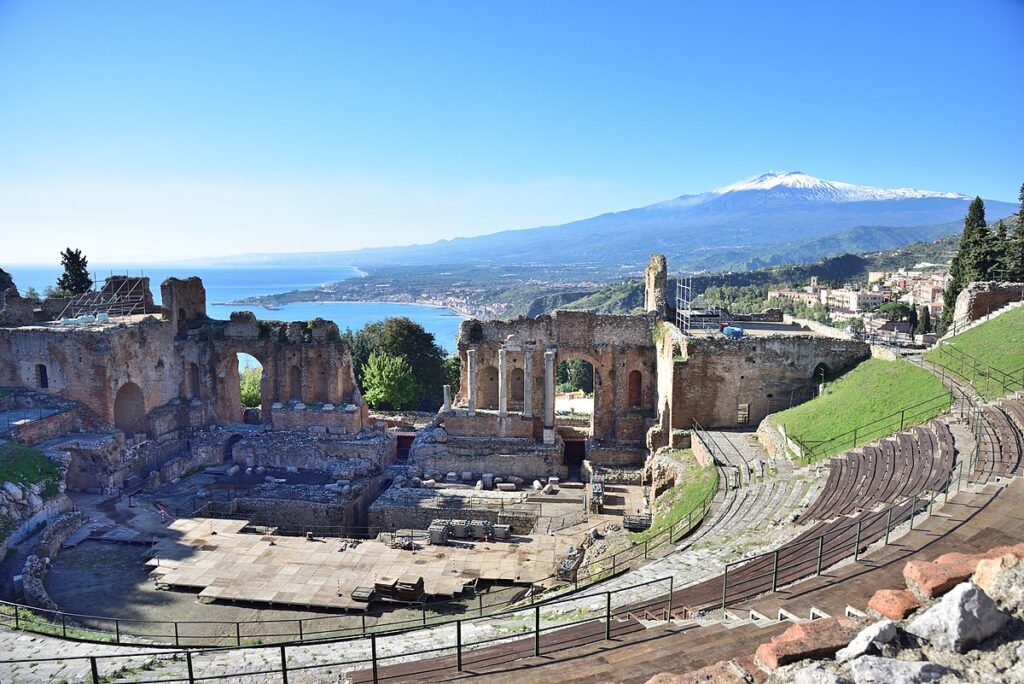
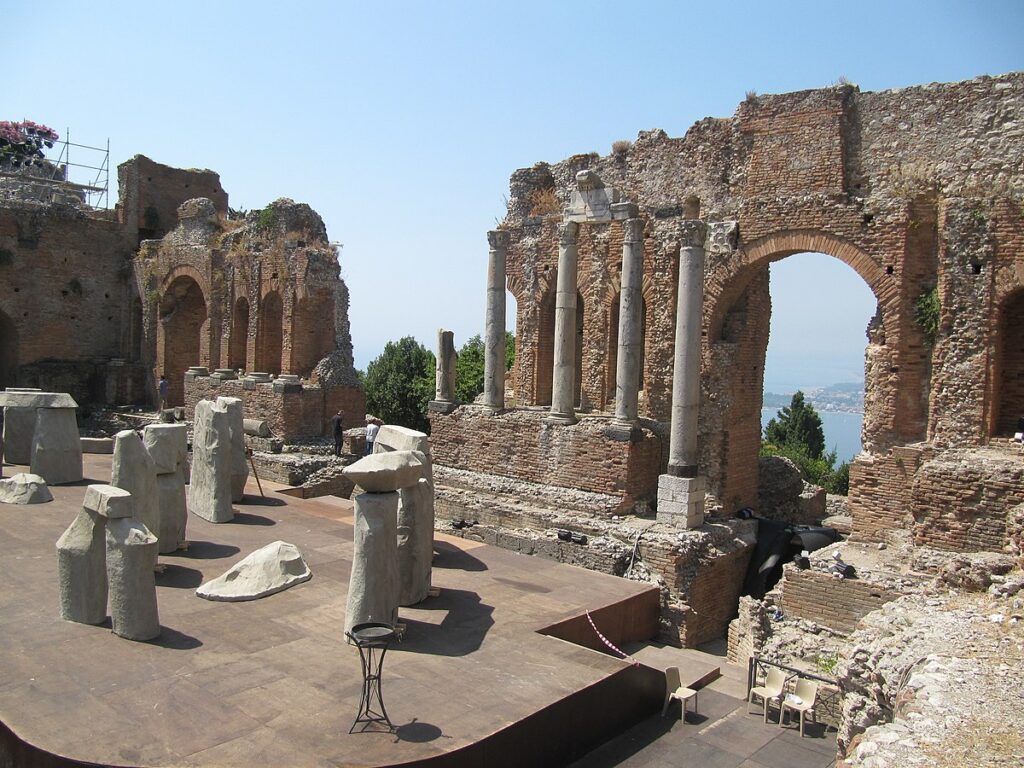
Here is what the historian Goethe said about this place
«If you place yourself at the highest point occupied by the ancient spectators, it must be recognized that, probably, a theater audience never saw something like this before. On the right side there are castles with overhanging cliffs; further away, below us, lies the city and, although its houses are of recent times, they certainly occupy the same places where others once stood. In front of us the whole, long mountain massif of Etna; on the left 1a shore of the sea up to Catania, or rather to Syracuse; and the very wide picture is closed by the colossal smoking volcano, which in the sweetness of the sky appears farther and more gentle, and does not inspire terror. “
2. Corso Umberto
Corso Umberto is the historic center of Taormina and is bordered at both ends by the two ancient Porta Messina and Porta Catania. Almost 1 km of pedestrian area in the heart of the town, full of art, history, shops and lots of good food.
The various buildings that overlook the course all have a different history. In fact, the architecture is very varied and fully reflects the different dominations, from the Arab to the Norman. In this regard, you will notice that right in the middle of the course, is the Clock tower , built around the 12th century. This divided the medieval village from the Roman and Hellenistic part. Corso Umberto is the beating heart of Taormina, with its small alleys and stairways, picturesque corners, artisan shops, restaurants and many, many monuments. Let’s find out some of them.
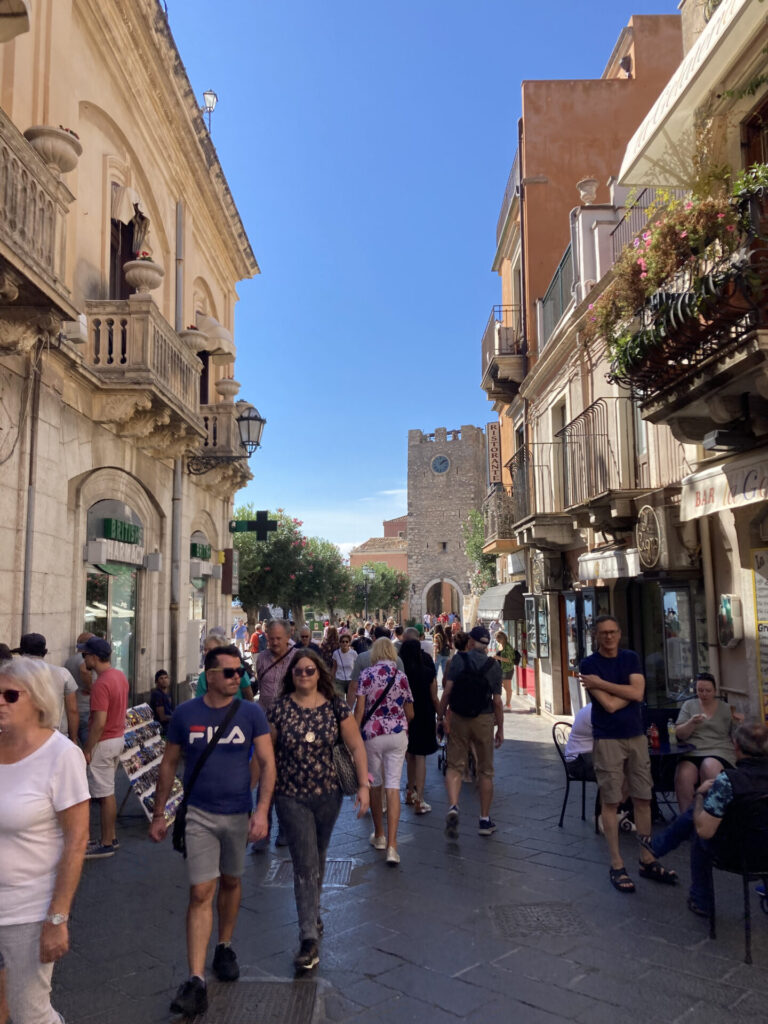
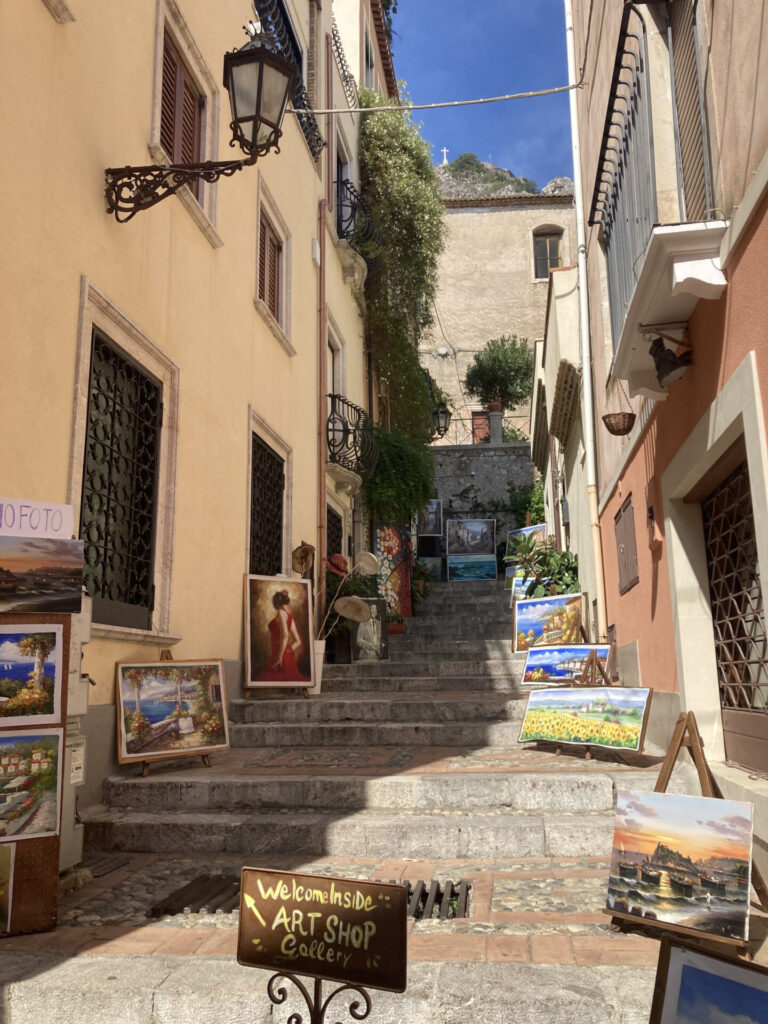
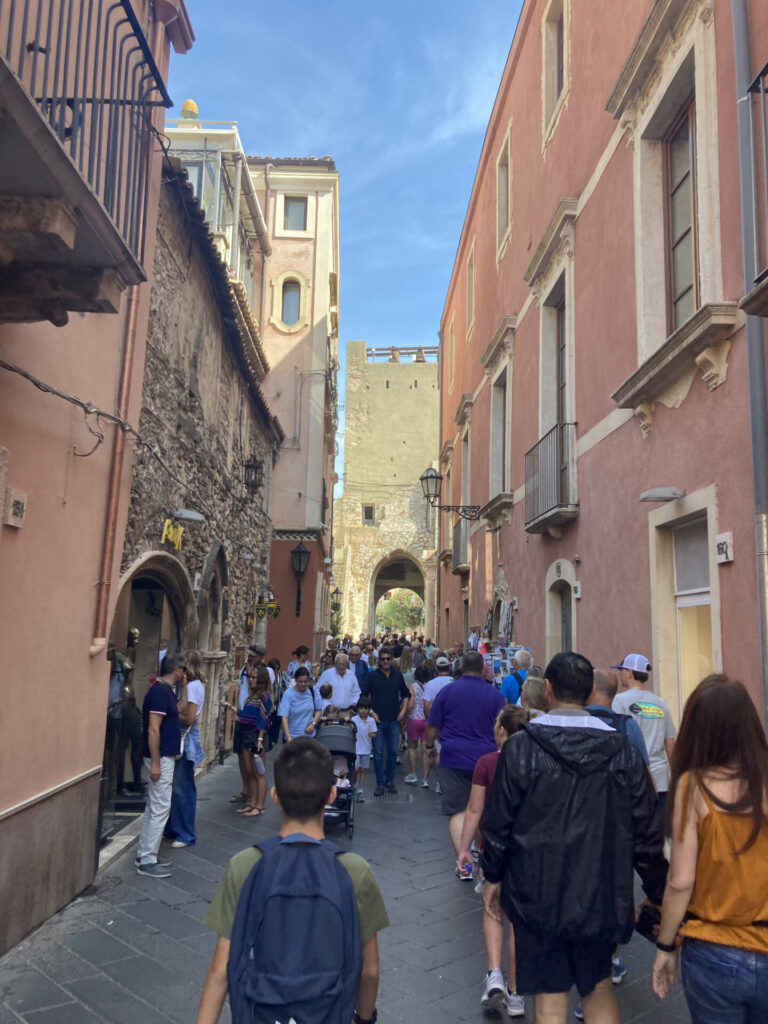
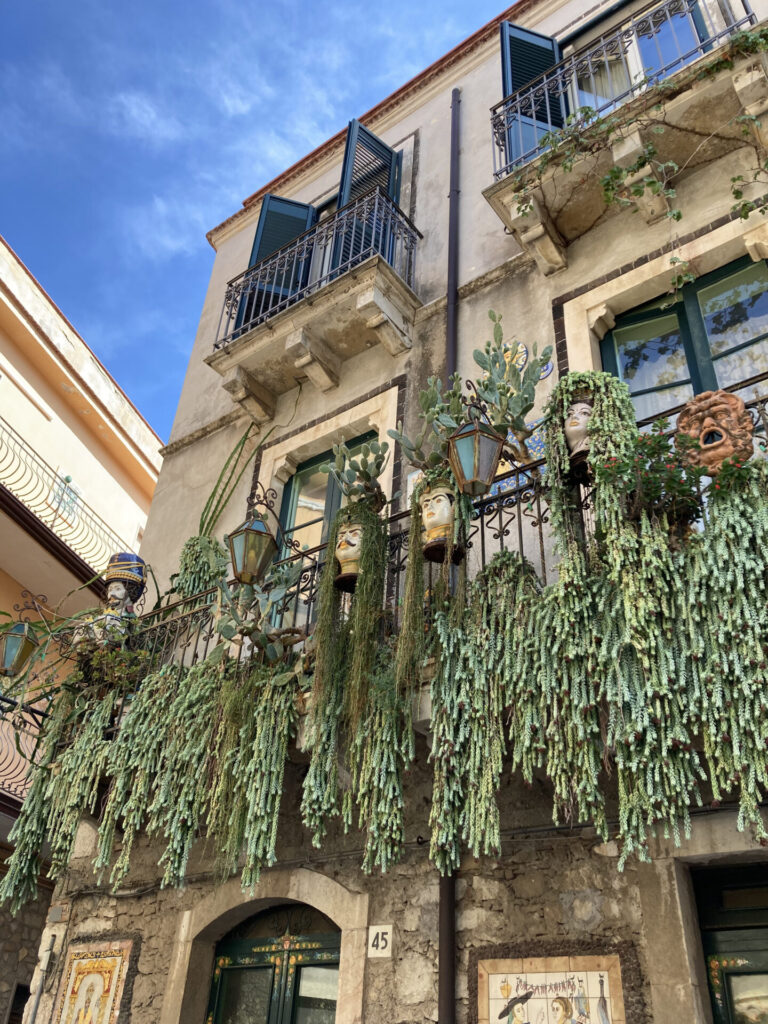
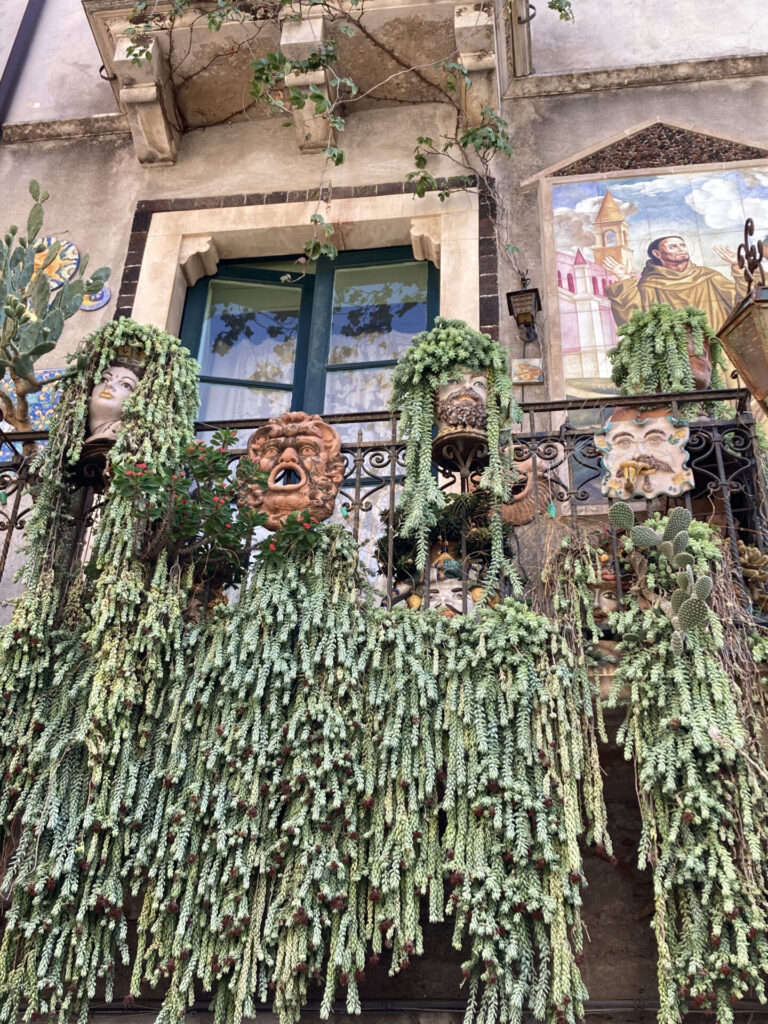
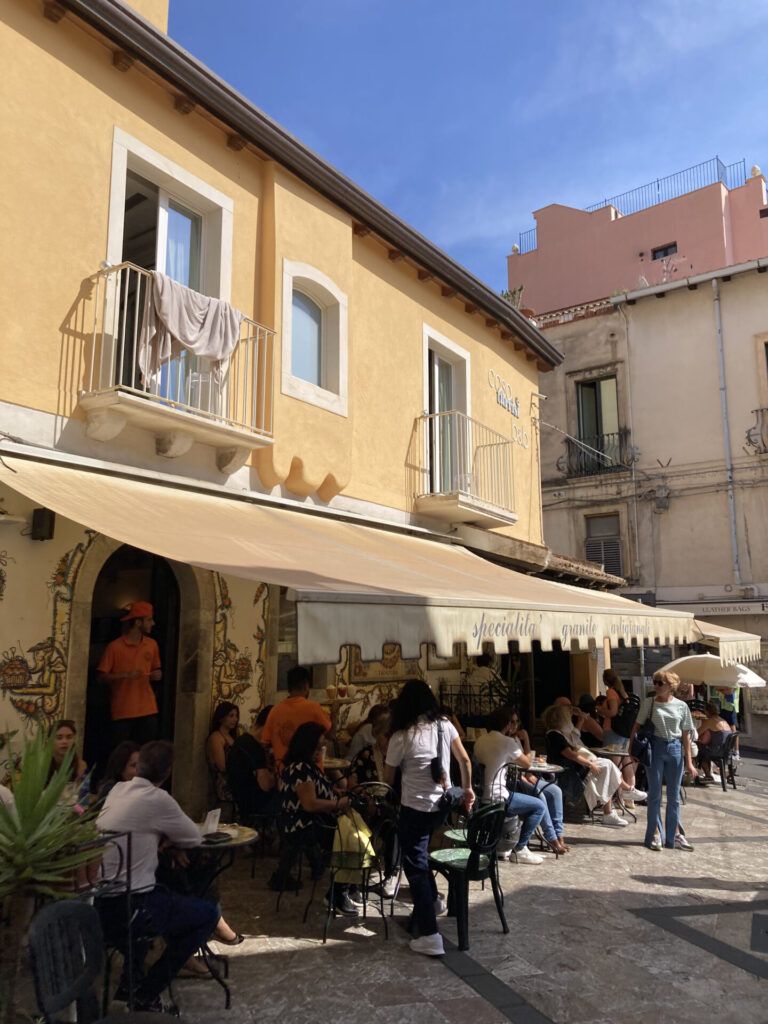
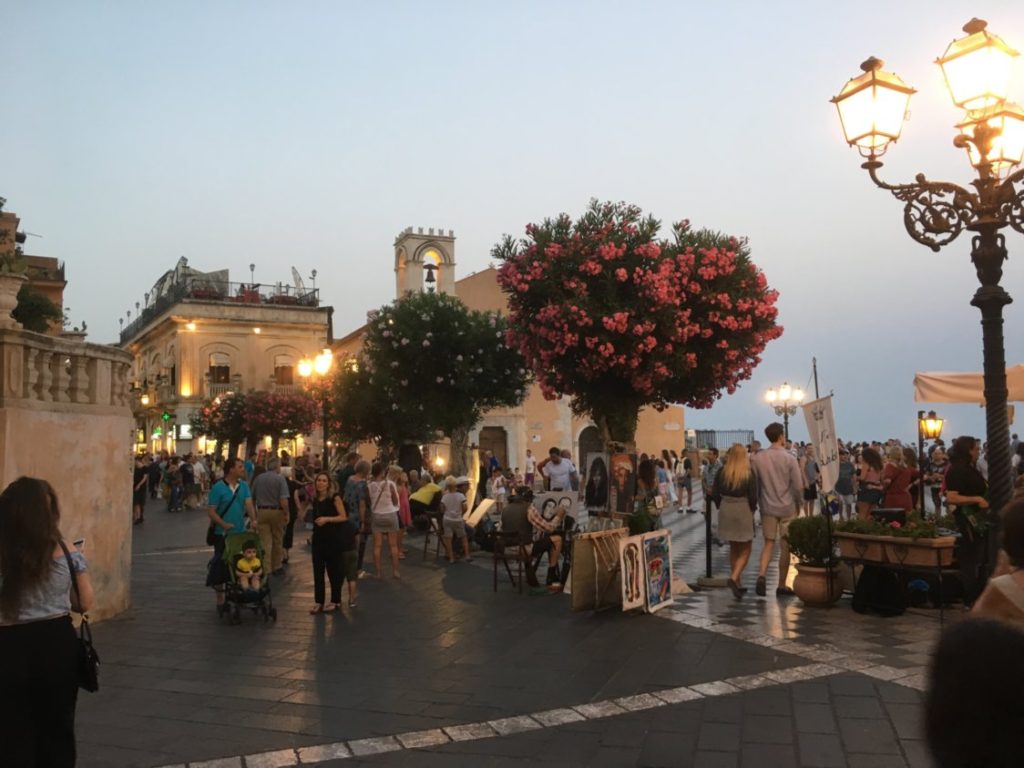
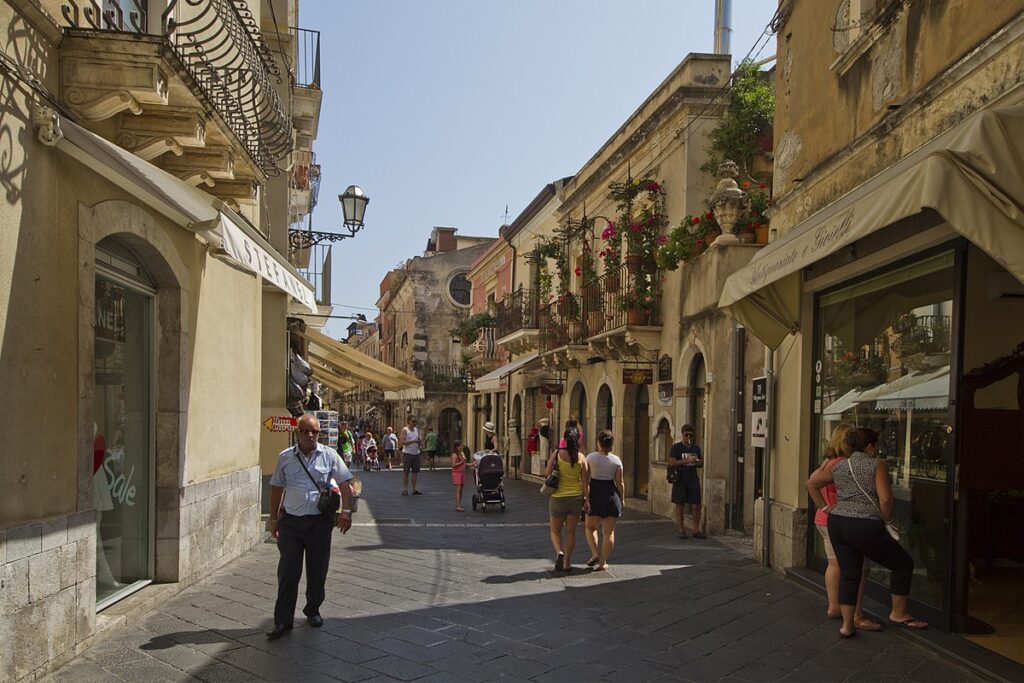
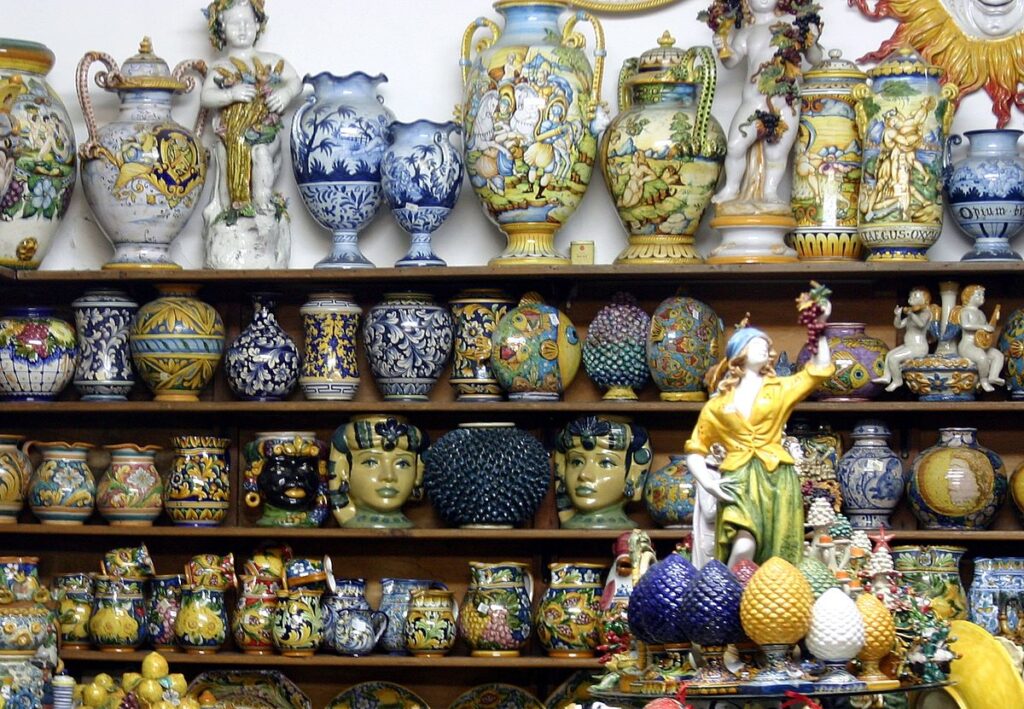
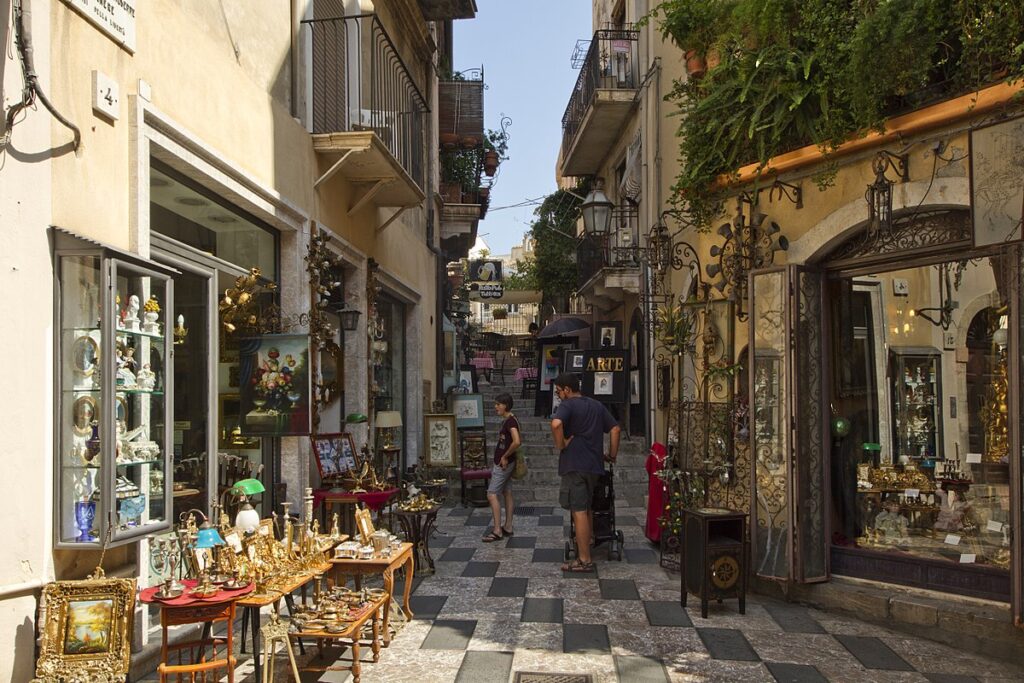
3. Odeon Roman Theater
What to admire during the walk? Don’t miss the little one Roman theater Odeon , built around the second century AD, located near the Messina gate. At the time it was intended for musical and theatrical performances and contained no more than 200 people. It was also a covered theater, the only one in Sicily, together with the Odeon of Catania. It was discovered by chance in 1893 and today, after long restorations, it has been opened to the public. Admission is free.
Right on the ruins of the Roman theater there is also the church of Santa Caterina , built around the seventeenth century and within walking distance of the Corvaja Palace .
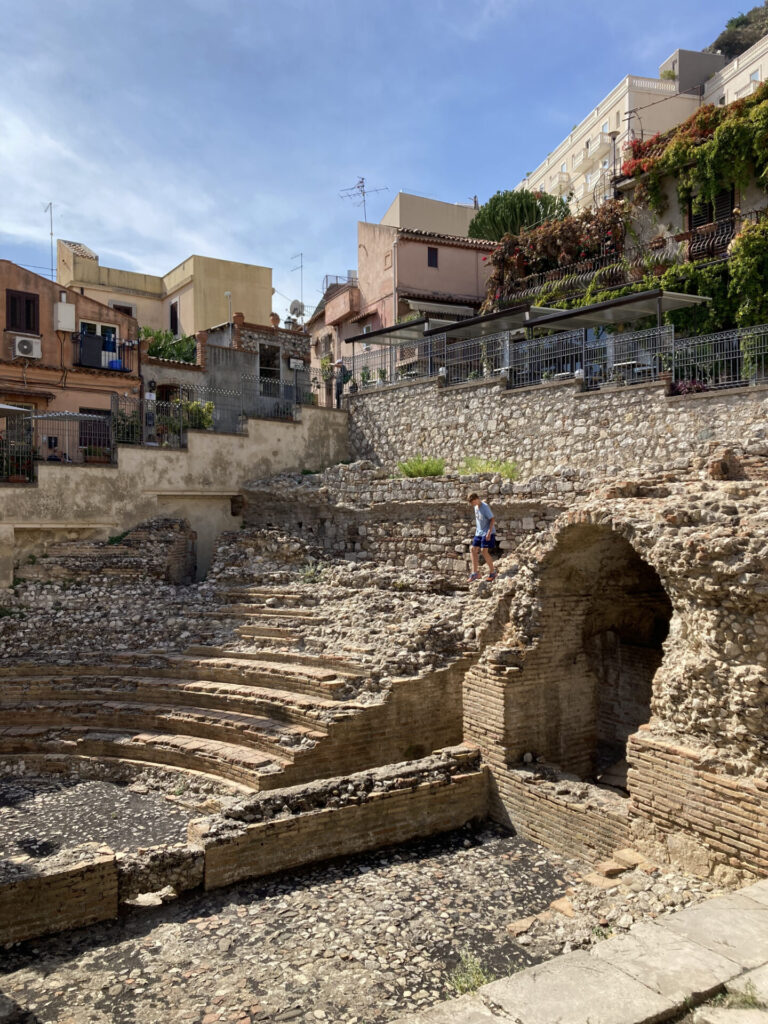
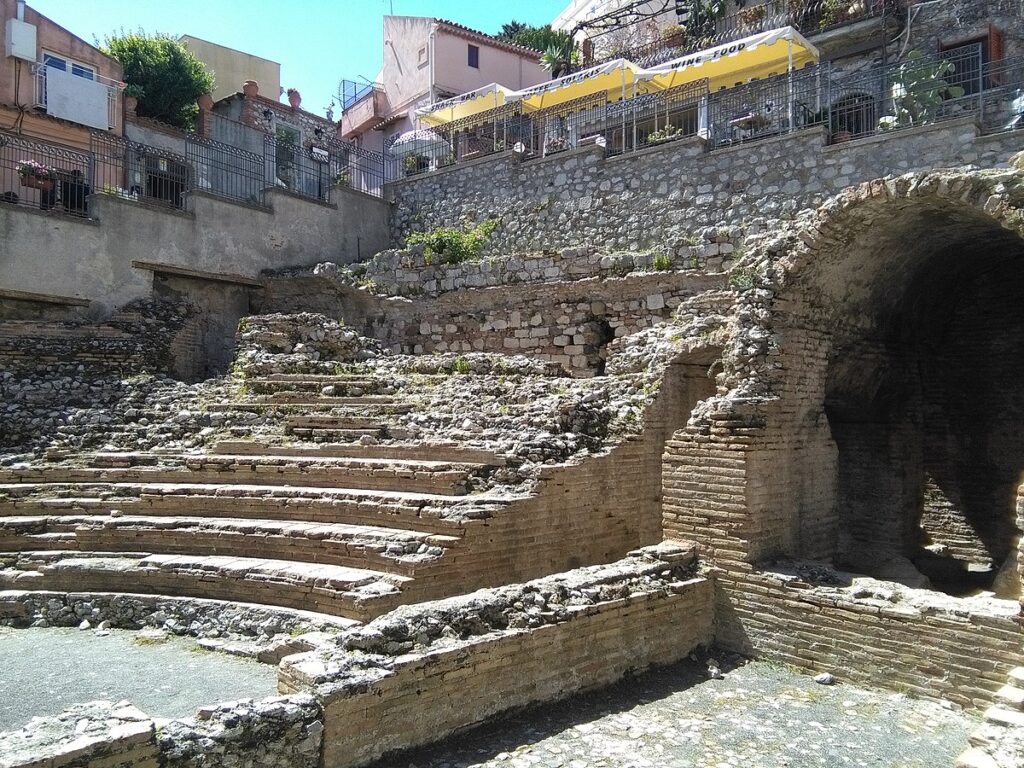
4. Corvaja Palace
The first construction of the latter took place in the Arab era (11th century) with the construction of the cube-shaped tower. Subsequently it was enlarged by the various civilizations that followed one another and therefore assumed the current conformation, daughter of Arab, Norman, Catalan Gothic and Chiaramontan influences. For a long time, until the Second World War, it was inhabited by the powerful Corvaja family from which it takes its name. Today Palazzo Corvaja houses the Sicilian Museum of Popular Art and Traditions and also the tourist information office.
Proceeding towards Porta Catania at number 42 you can admire the former church of Santa Maria del Pilliere with its magnificent Renaissance portal. It was probably built around the 16th century. Today it has become a very nice place, with a small terrace overlooking the street.
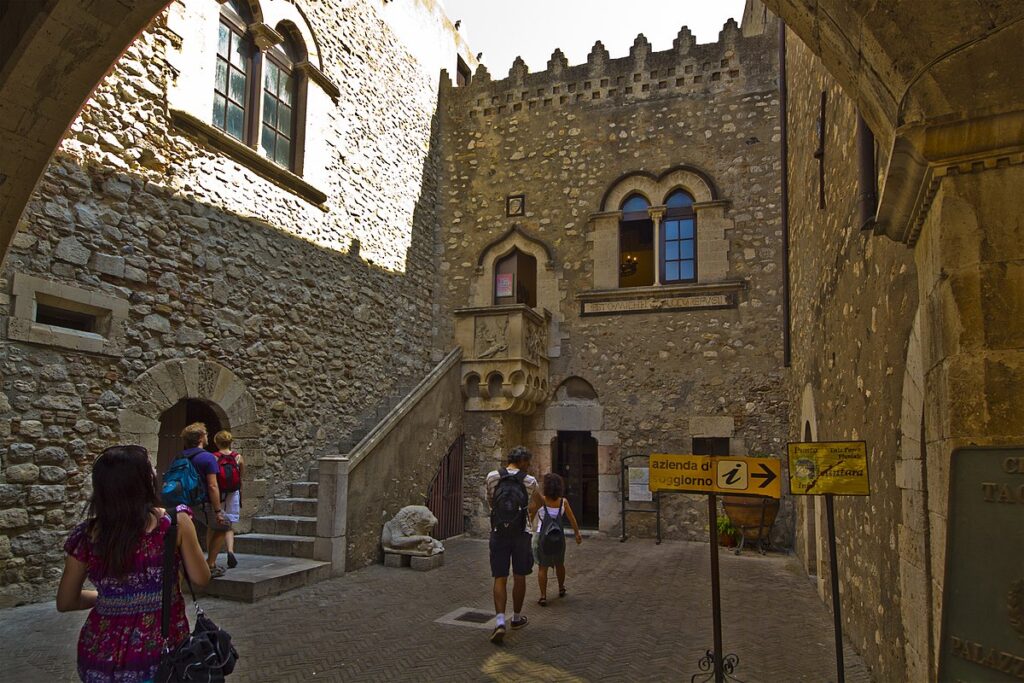
5. Naumachie
A little further on you will find Via Naumachia, which will lead you to the discovery of ancient Roman walls. Unearthed only in 1943, the Naumachie they are a long red brick facade from the Roman era, built around the 2nd century AD. The name Naumachia literally means “naval battle”. In fact, it was once believed that the monument was a representation of naval battles, while in reality it is probably a sacred place dedicated to a nymph.
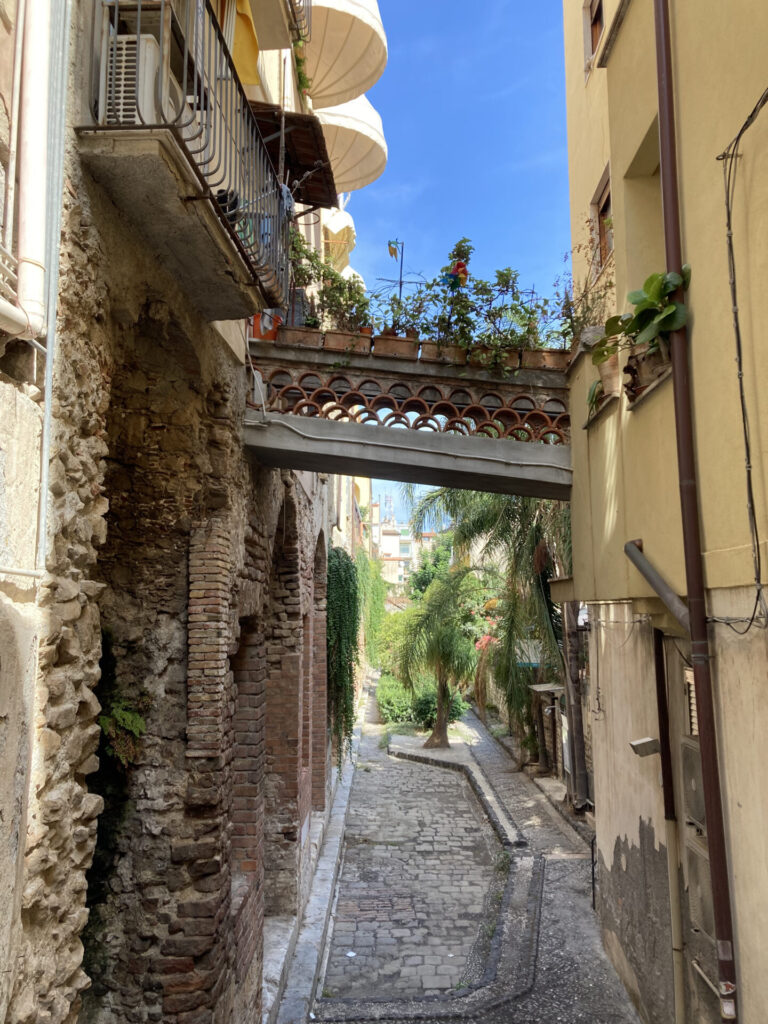
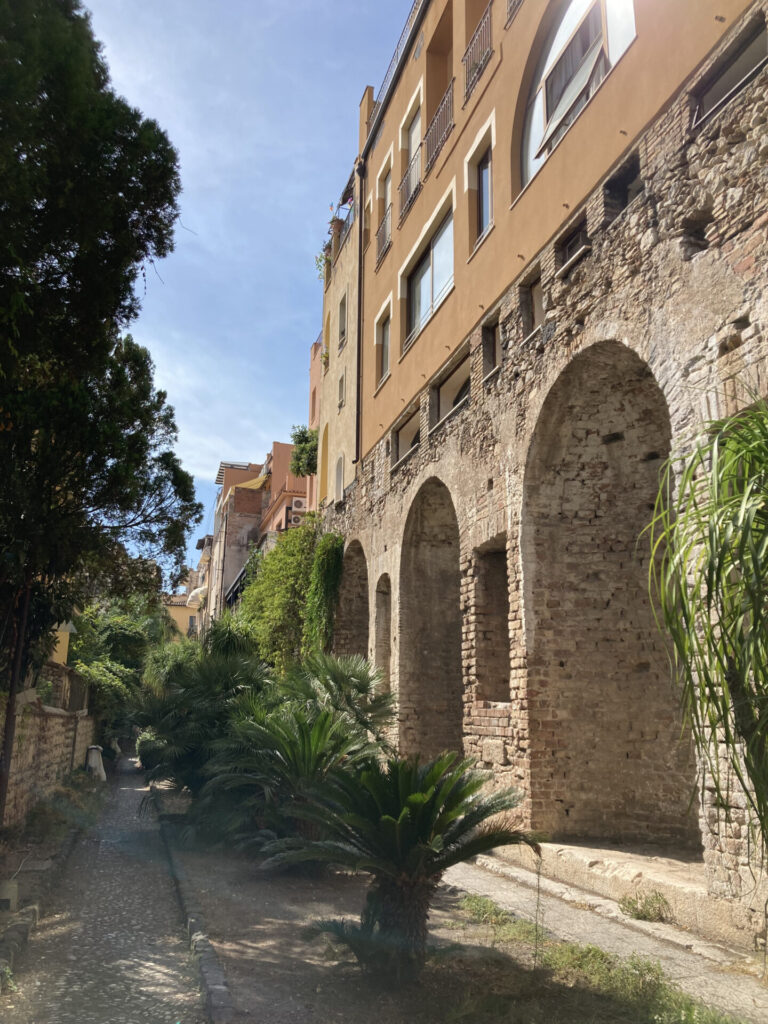
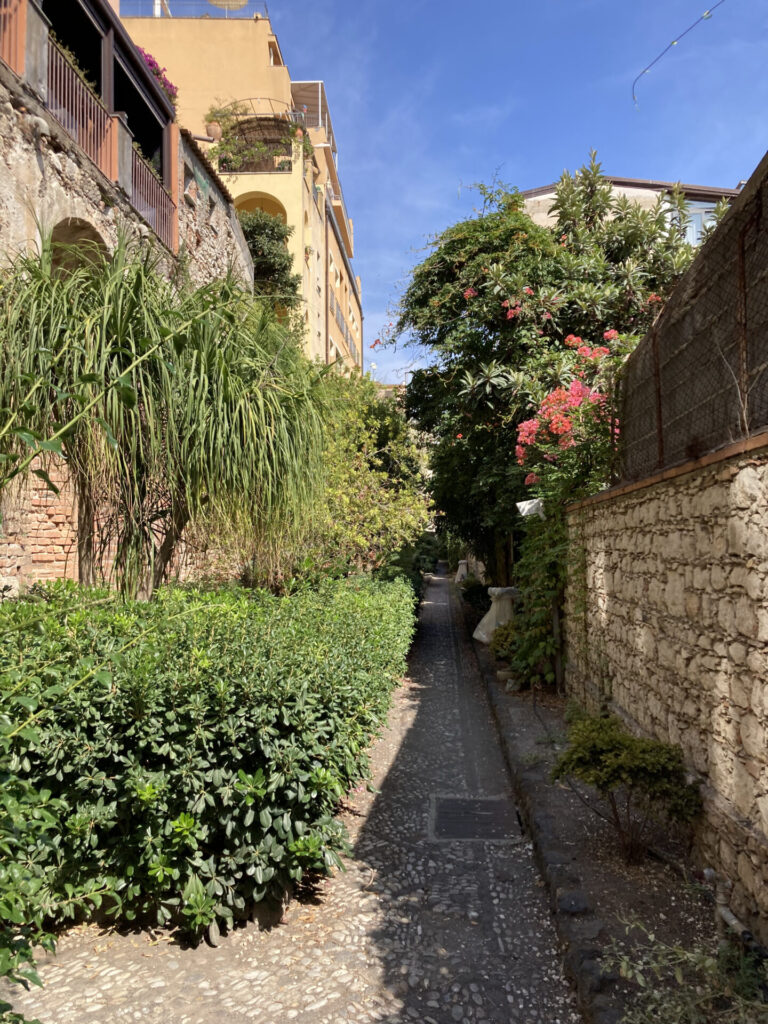
6. Piazza IX Aprile
Piazza IX Aprile is located in the center of Corso Umberto. You will feel like you are inside a painting, between hills, sea, volcano and monuments. From the panoramic side you can in fact admire the sea, the bay of Giardini-Naxos and the majestic Etna . Behind you instead, you can enjoy the architectural show created by the monuments that overlook the square itself.
Very fascinating is the Church of San Giuseppe , built in the 17th century, with its light pink facade, is a fine example of Sicilian Baroque. Of great beauty is certainly also the double staircase located in front of the entrance.
The most important building in the square is certainly the Clock tower, originally built in the 12th century, but destroyed and rebuilt several times over time.
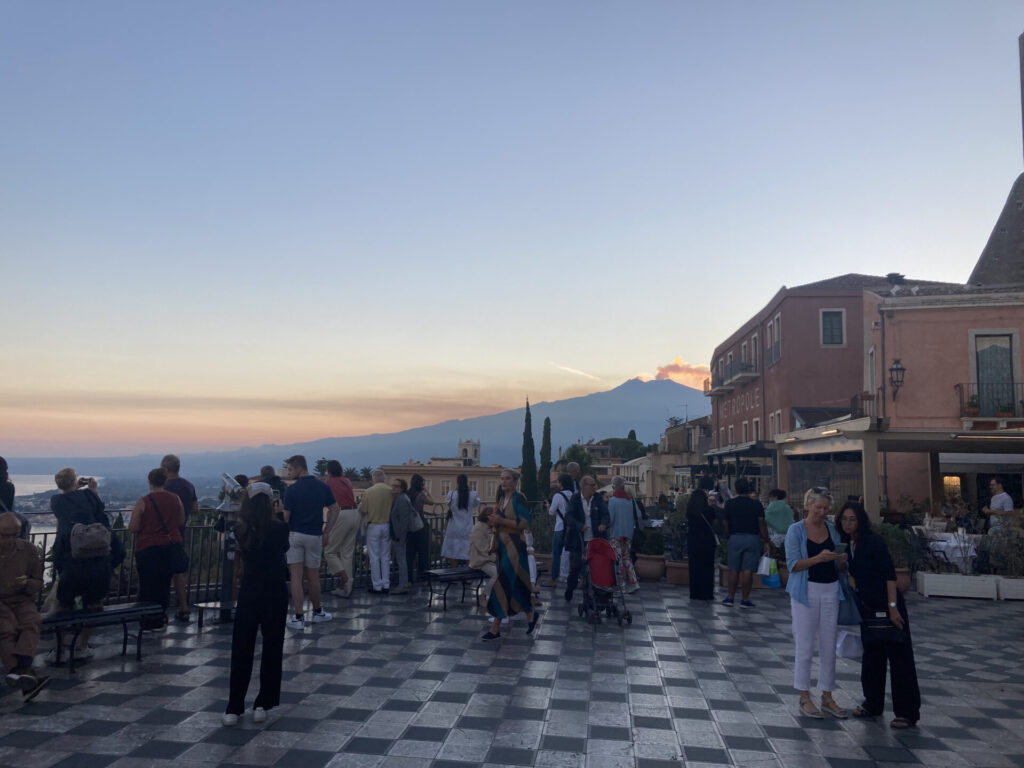
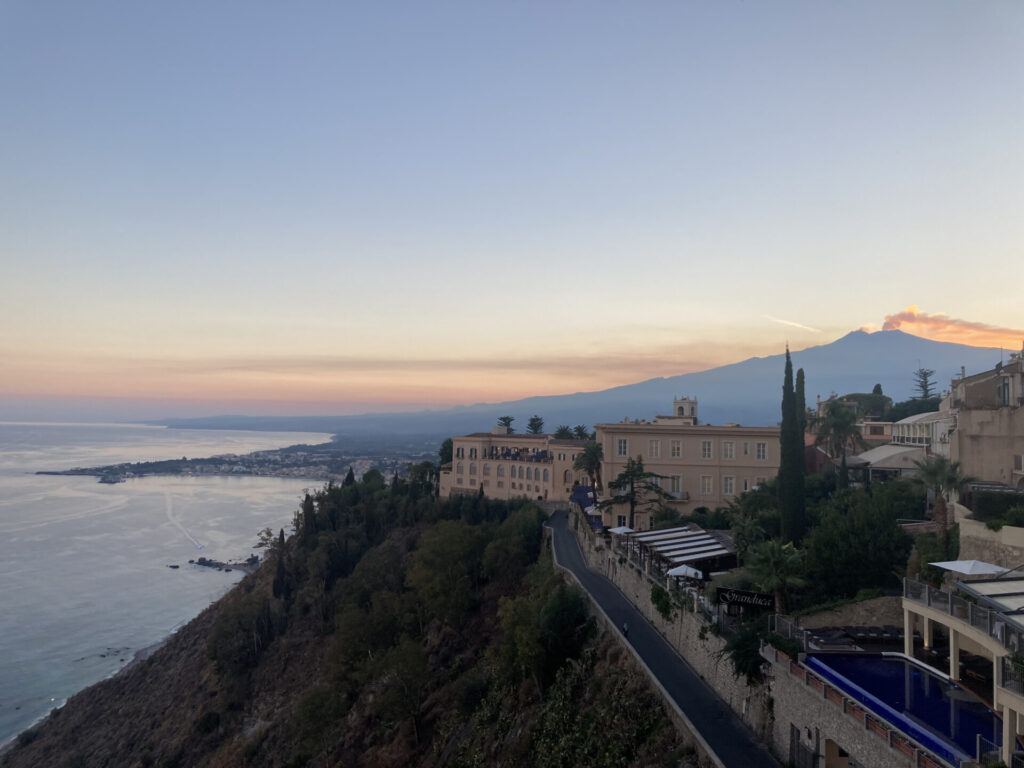
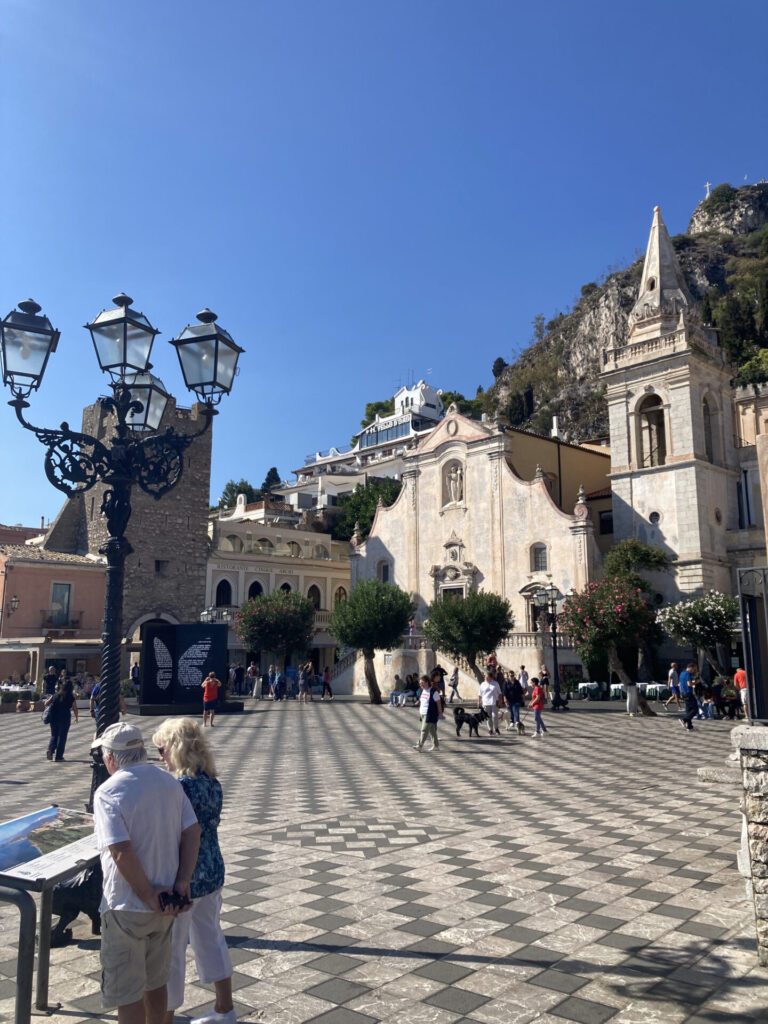
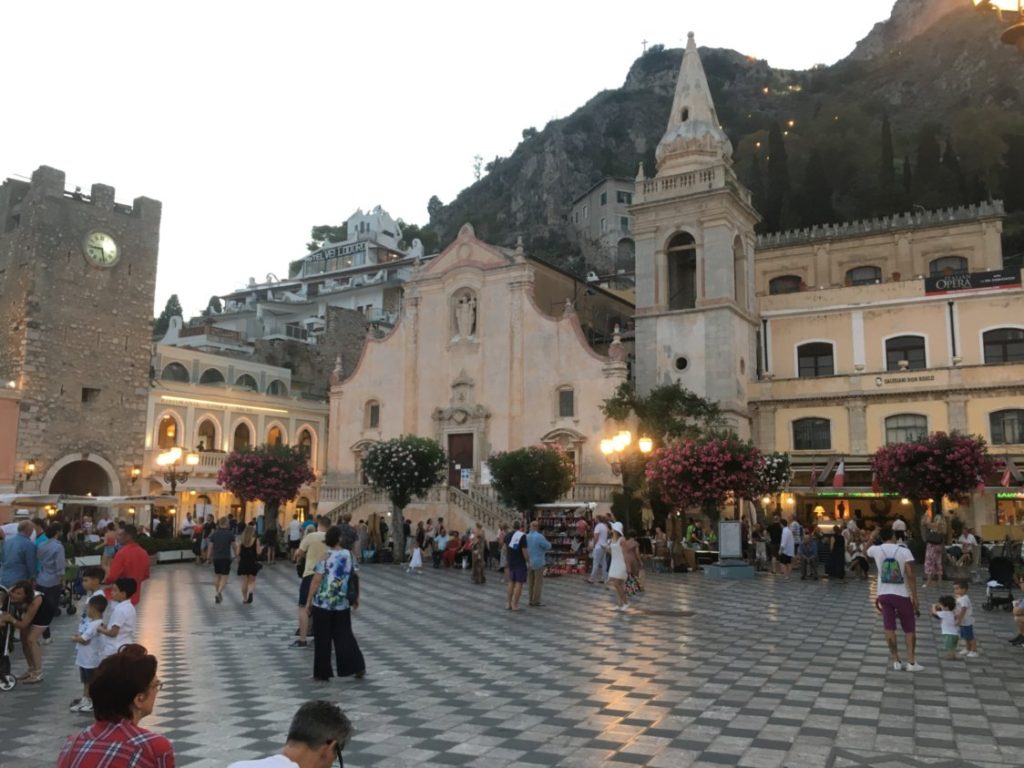
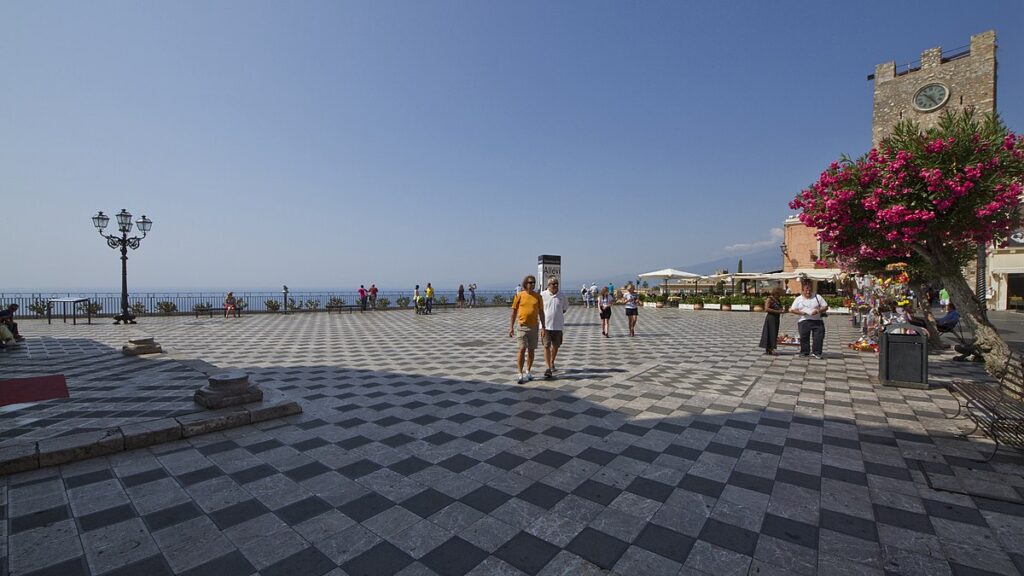
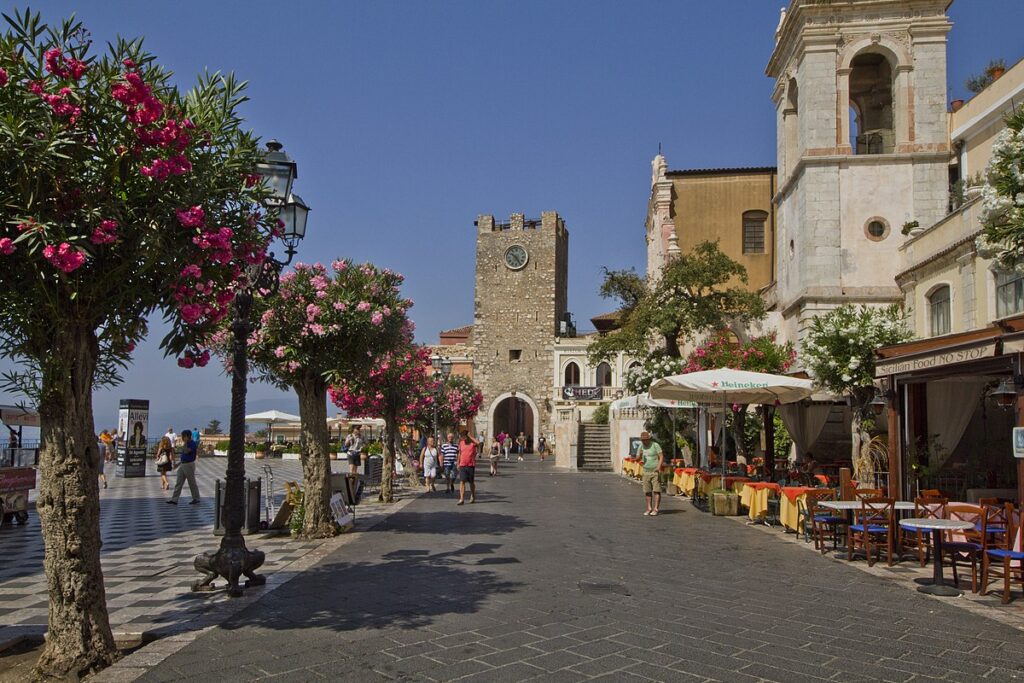
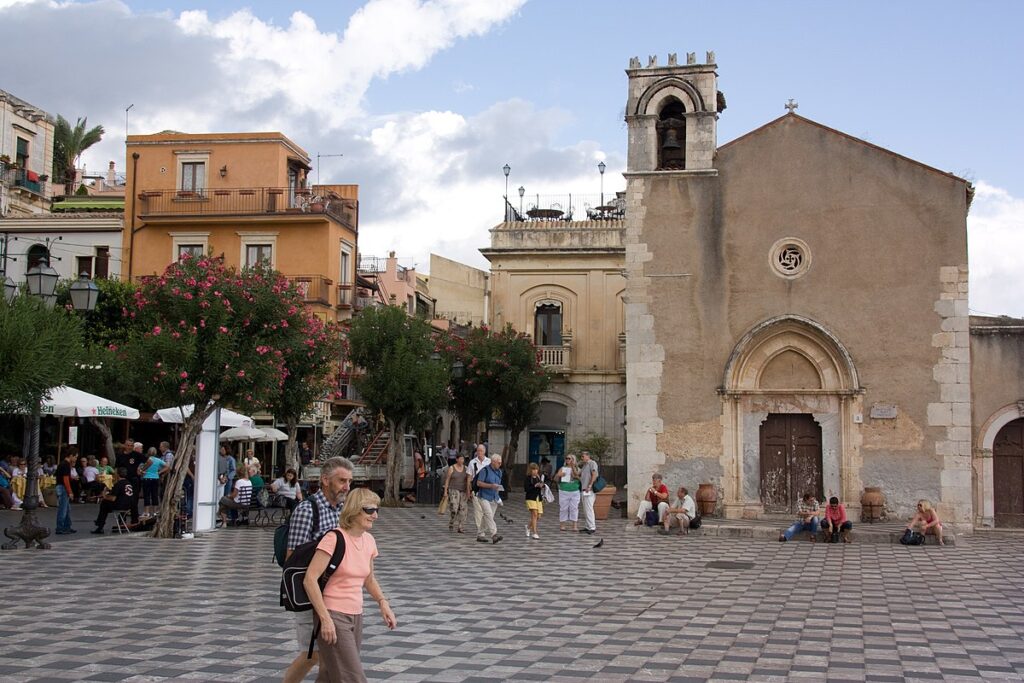
Curiosities about the square
The name of the square dates back to April 9, 1860 , when during a mass in the cathedral of Taormina spread the rumor that Garibaldi had landed in Marsala, to free Sicily from the Bourbons.
In reality, the news turned out to be false, in fact Garibaldi landed in Marsala exactly one month later, on 9 May 1860. Despite this, the inhabitants of Taormina still wanted to remember that date by dedicating the most beautiful square in the town to it.
7. Cathedral of Taormina
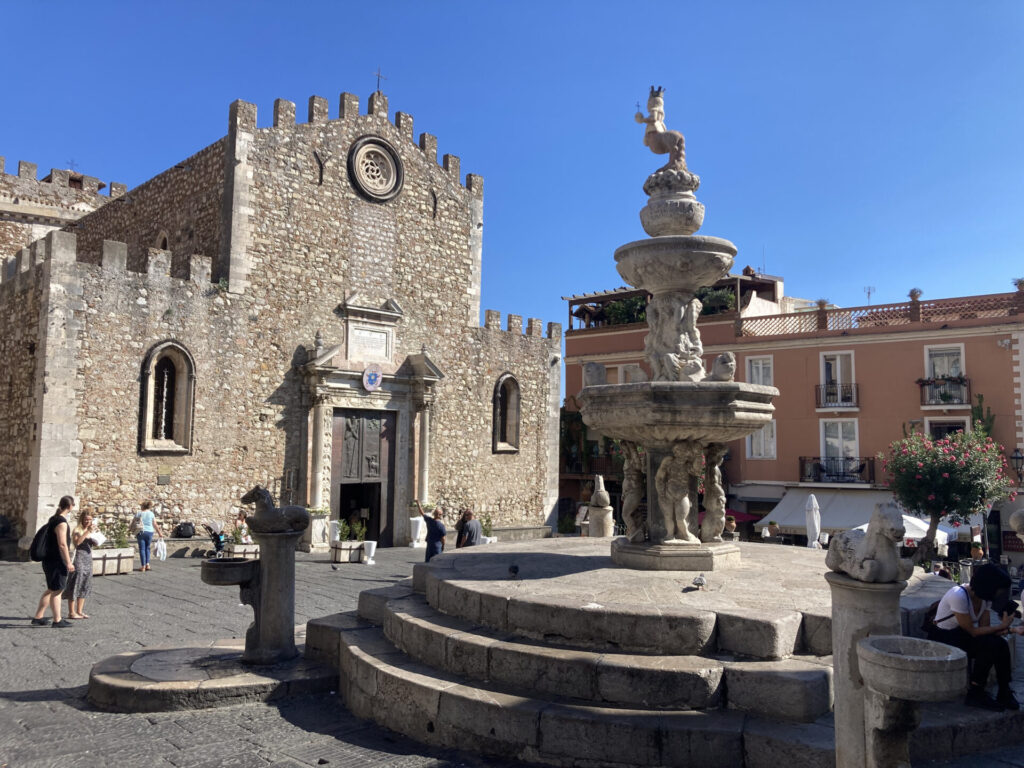
The Cathedral of Taormina built in 1504 is dedicated to San Nicola and is a sort of medieval fortress church . The center of city life took place during the Middle Ages around its square, where one also stands beautiful fountain made in Baroque style, around 1635 .
8. Palace of the Dukes of Santo Stefano
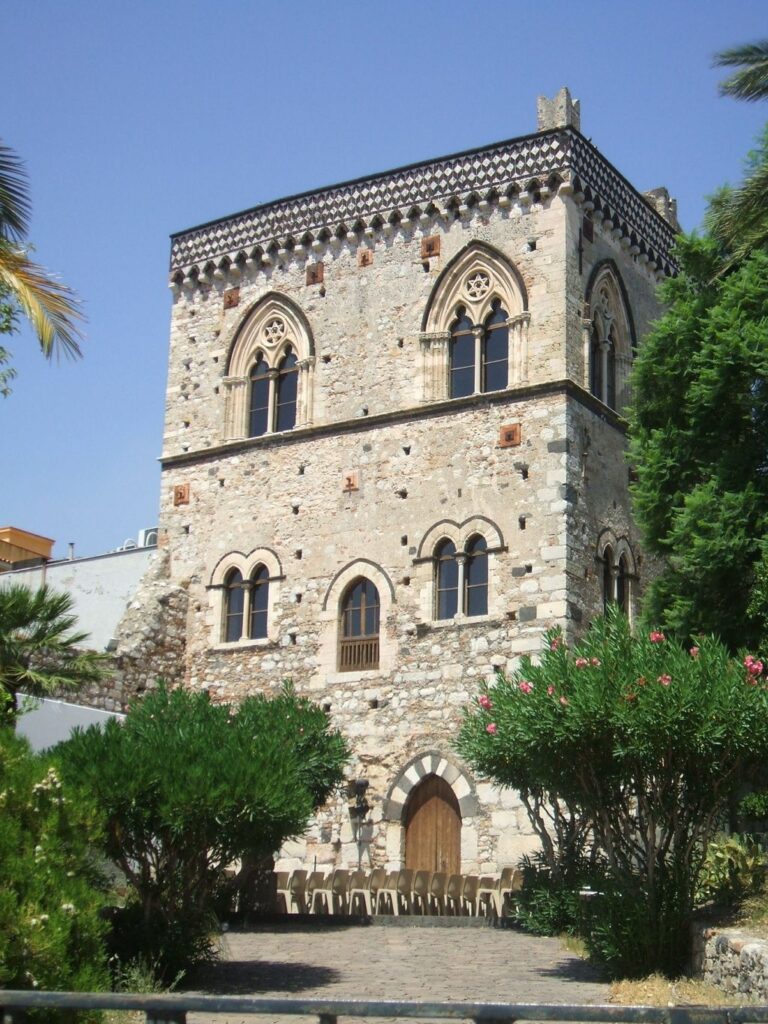
The Duchi di Santo Stefano Palace is located near Porta Catania. It was built between the end of the 1300s and the early 1400s and was an integral part of the medieval walls of Taormina. It was inhabited for a long time by the Spanish De Spuches family and was bought by the Municipality in 1964. Like many other monuments, it presents decorations and architectural structures belonging to different civilizations, in this case the Arab and Norman ones. Unfortunately it was destroyed by the bombing of the Second World War but was then rebuilt after the war.
The garden of the building is also very beautiful, in which there is still a well for collecting rainwater and an excellent place to relax away from the bustling Corso Umberto.
The palace is now the headquarters of the Mazzullo Foundation. Numerous works are exhibited by the artist Giuseppe Mazzullo, born in Graniti, a small town near the suggestive gorges of Alcantara .
9. Municipal villa
The Villa Comunale of Taormina is a real green lung, ideal for lovers of nature and relaxation. At the time it was a simple plot of land intended for agricultural production, but with its purchase by the Scottish noble woman Lady Florence Trevelyan, it was transformed into a typical English garden in which many species of rare plants and particular constructions of stone, wood and brick called “Victoria Follies” were erected. Their purpose was purely ornamental, although Lady Florence Trevelyan loved to sit there and read.
The noble woman was also a lover of dogs, in fact she owned 5 and after their death, she had a funeral monument erected in the villa in their honor. This is the cromlech, a small stone garden made up of small menhirs and dolmens, inspired by megalithic sites.
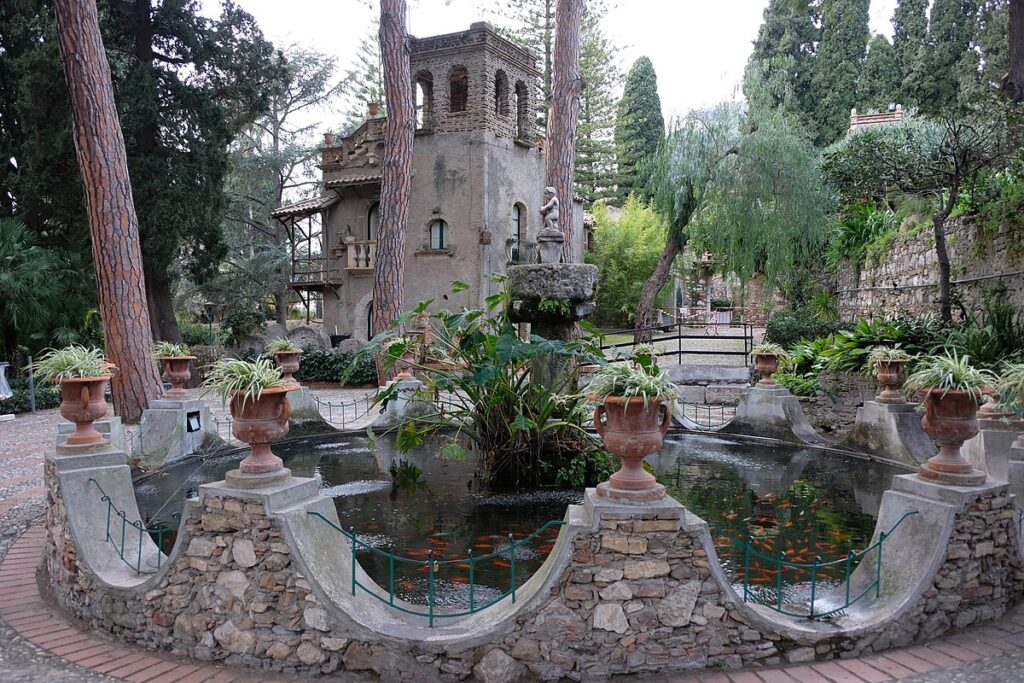
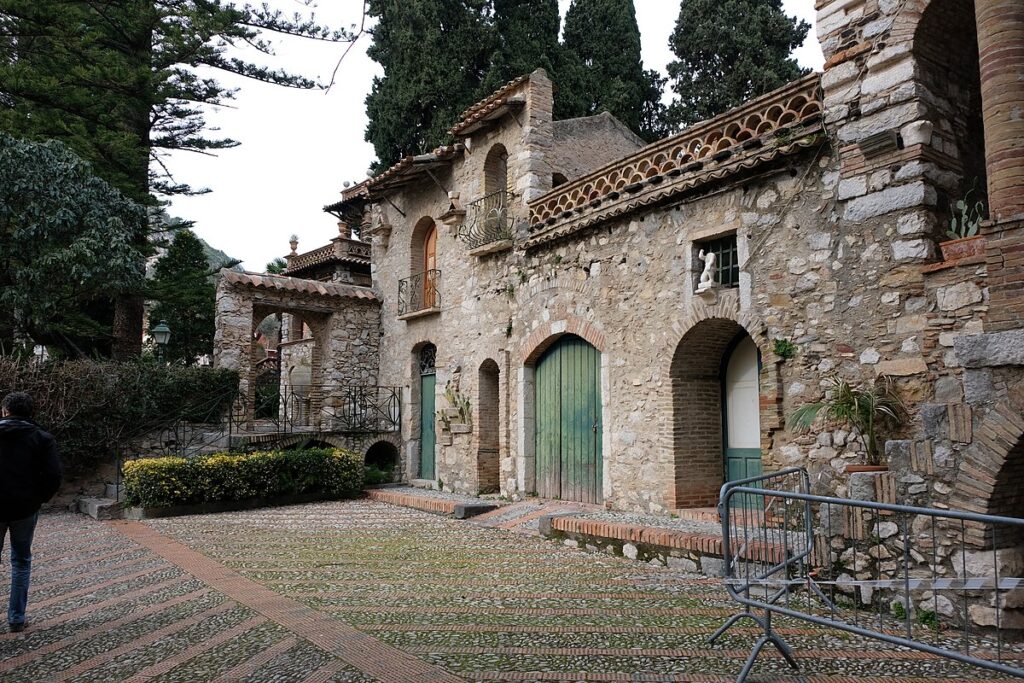
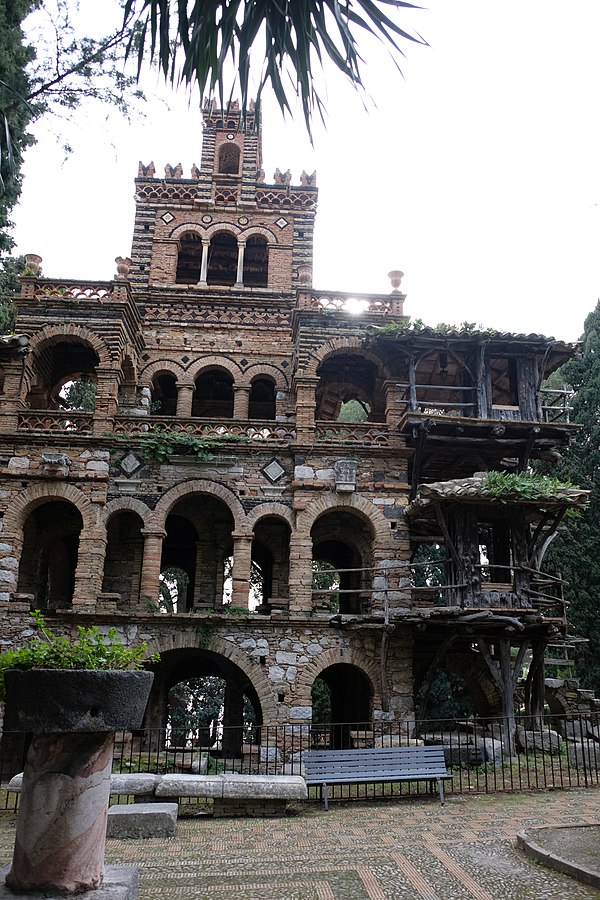
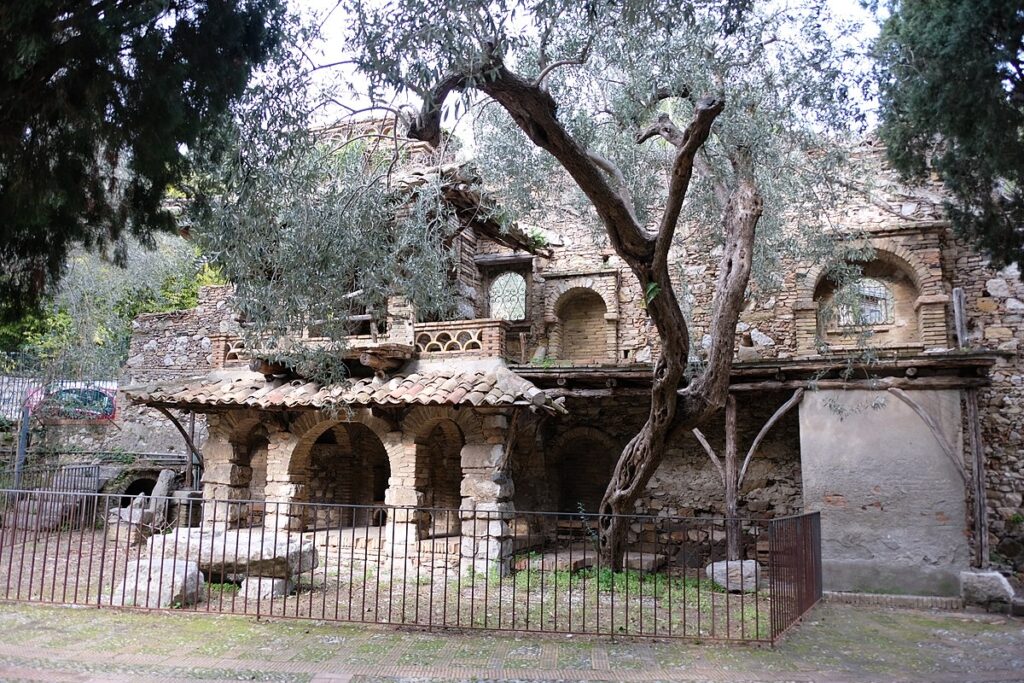
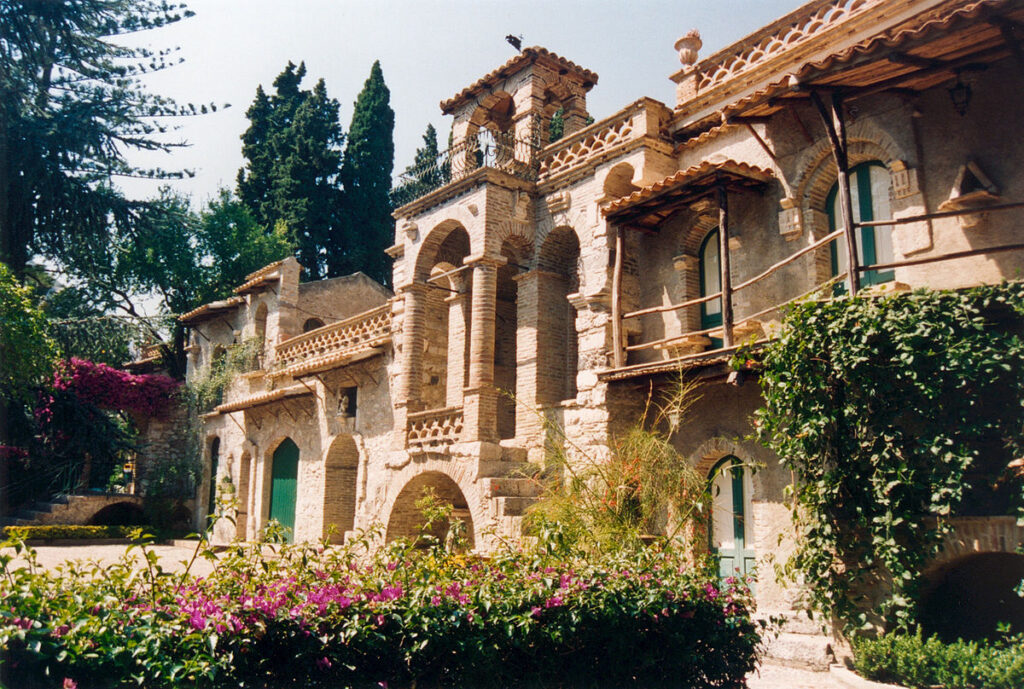
10. Madonna of the Rocca
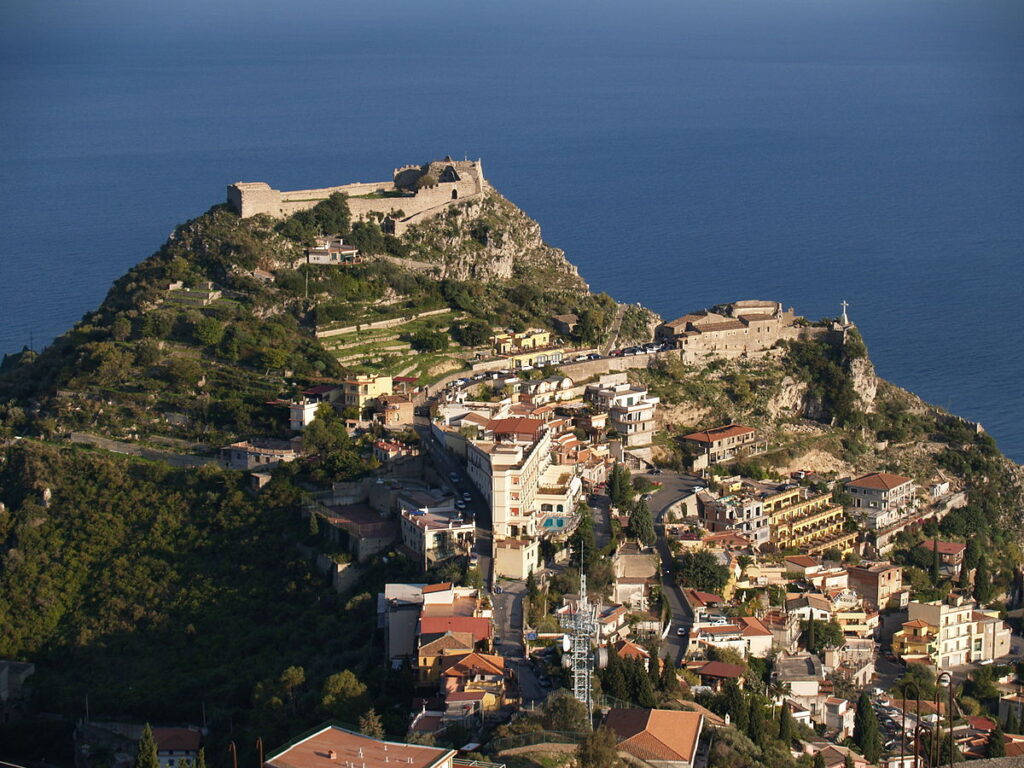
The church of the Madonna della Rocca is located on the steep mountain overlooking Taormina. It was built taking advantage of the cave conformation of the existing rock, so much so that part of its ceiling is made up of living rock, the so-called Taormina stone. A little further up is the Saracen Castle, which is unfortunately still closed to the public.
To get to the small sanctuary it is recommended to take the Via Crucis path, a staircase that starts from the Via Circonvallazione, in front of the house number 20 . The climb could be a bit tiring, but it is absolutely worth it, you will enjoy the most beautiful view of Taormina and beyond. From there you can admire Taormina and the Greek Theater from above, see the hills gently descend to the sea, Mount Etna and the bay of Giardini-Naxos. Sea, hills, volcano, snow, history, nature and the city, all this enclosed in one place.
Another beautiful panoramic path is that of the Saracens, which takes you in about 45 minutes on the beautiful one Castelmola .
11. Isola Bella, the most beautiful beach in Taormina
Isola Bella is certainly one of the things to see in Taormina. The island was donated in 1806 to the municipality of Taormina by the King of the Two Sicilies Ferdinandi I of Bourbon. It was subsequently purchased by the noble woman Florence Trevelyan, who, as previously done with the villa in Taormina, transformed it into a large garden. The island subsequently passed to various families who bought it, until only in 1988 the Sicilian Region decided to take possession of the property and protect it. Today it has been declared a Natural Reserve managed first by the WWF and now by the Cutanga, in order to preserve and protect this little corner of paradise.
The beach and the seabed are mainly made up of large stones, so it is advisable to bring sea shoes with you. The strip of beach that connects it to the mainland is however made up of small pebbles.
Tip from Topsecretsicily: Here you can book a boat tour with aperitif at the beautiful island.
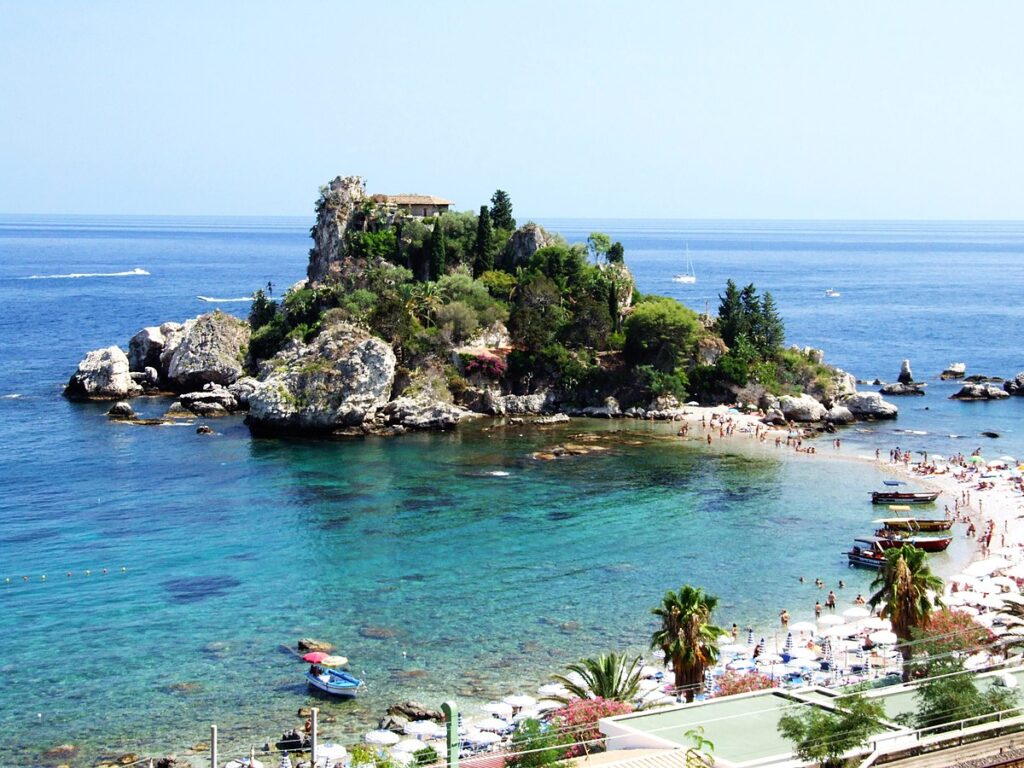
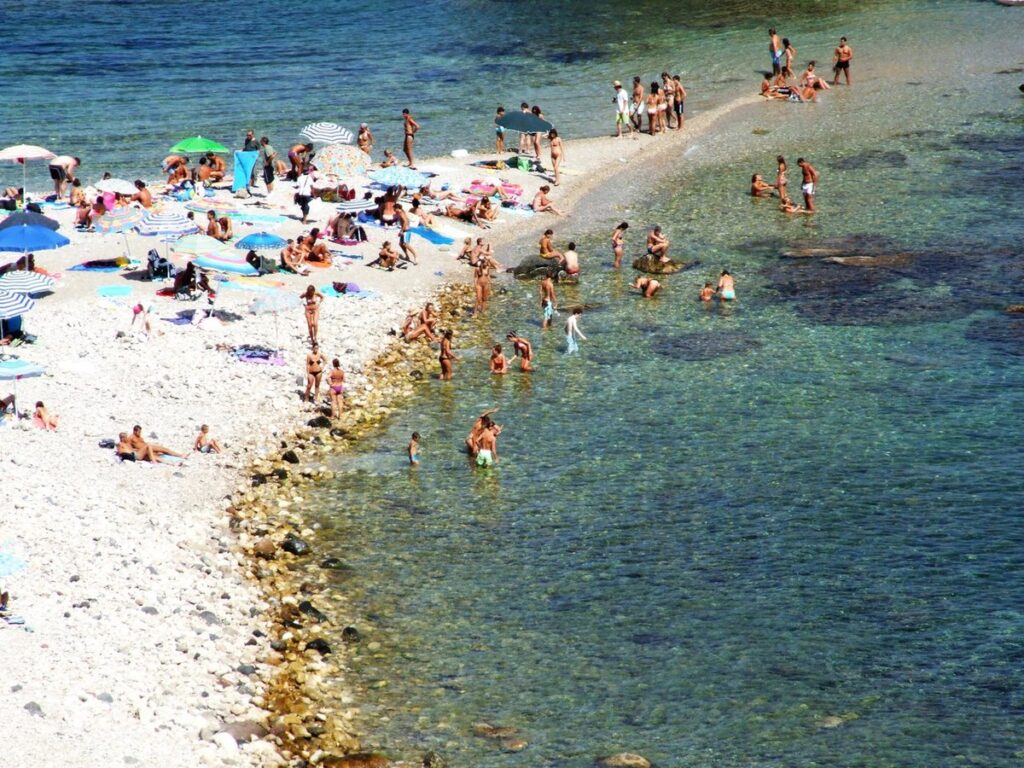
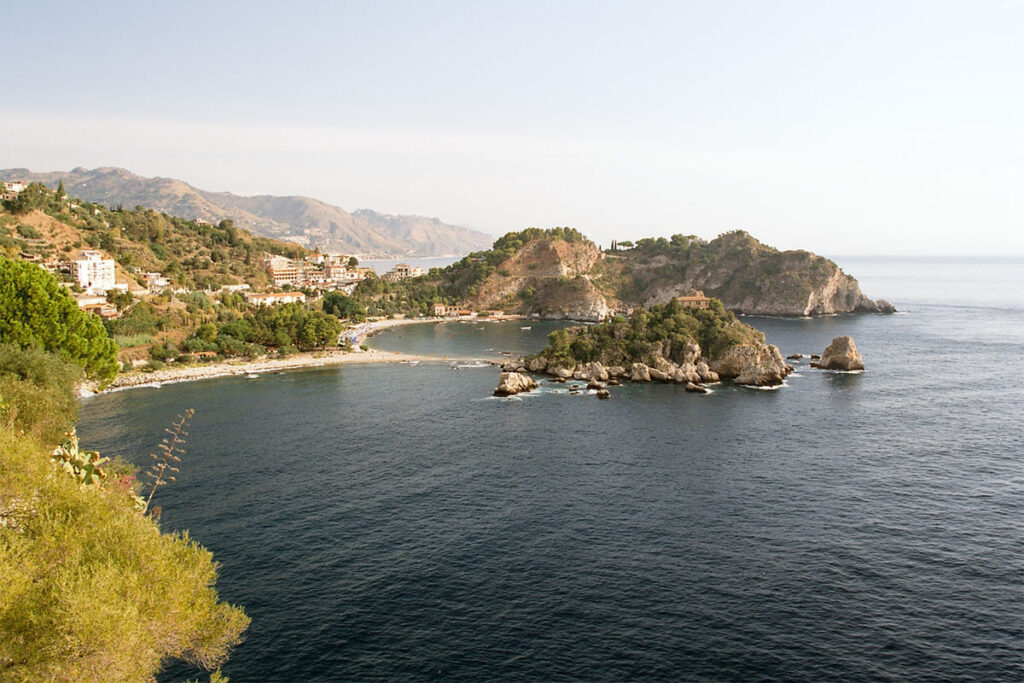
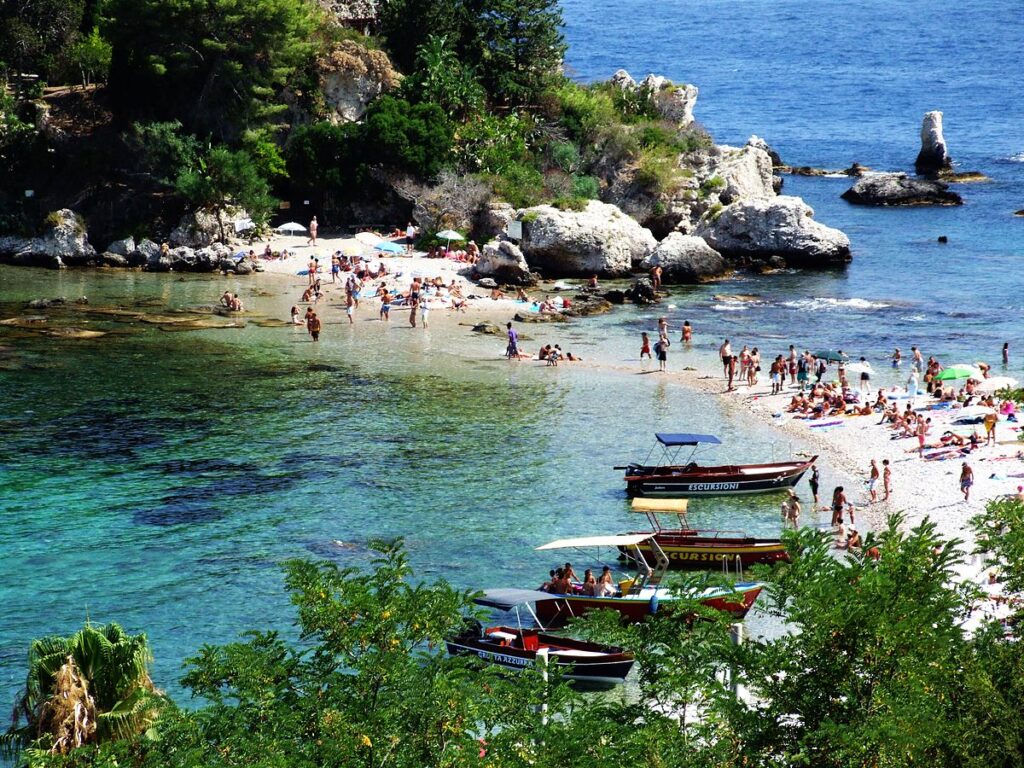
How to reach Isola Bella
To reach the island, you can take the cable car which is located near Porta Messina, or you can also go on foot, starting from the football field and following the path (Duration about 20/30 minutes).
Top Secret Tip – Goethe’s Path
From 2019 it is possible to take a walk and reach the Greek theater of Taormina, from a secondary entrance to a few known.
The main road for access to the Greek theater is very popular with tourists and is located in Corso Umberto. This new route, on the other hand, starts near the Villa Comunale, exactly from here . It is a path in the middle of the Mediterranean scrub with olive trees and ancient pines, which leads after a series of hairpin bends up to the mountain. From here you will see glimpses of the sea, Mount Etna and at the end the theater in all its magnificence.
Where to eat in Taormina
Taormina is full of good restaurants and the most popular are certainly the Trattoria Tiramisù and the Pizzeria Villa Zuccaro.
Advice on what to eat in the province there find here . Here you find the typical Sicilian dishes .
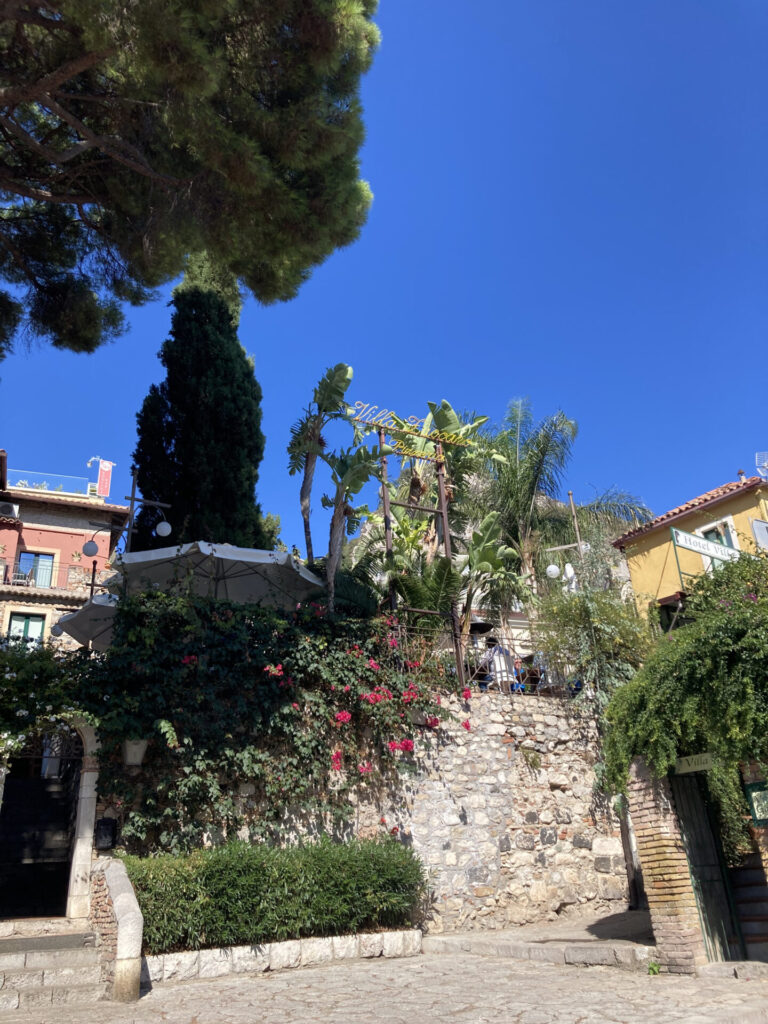
Interactive map of Taormina – Points of interest in purple
To locate yourself once in the area, click on the enlarge symbol at the top right of the map.
What to see around Taormina
Taormina is located in the province of Messina. Here you will find listed the places to visit in Messina and surroundings .
